light PONTIAC GRAND-AM 1994 Owners Manual
[x] Cancel search | Manufacturer: PONTIAC, Model Year: 1994, Model line: GRAND-AM, Model: PONTIAC GRAND-AM 1994Pages: 274, PDF Size: 15.01 MB
Page 4 of 274
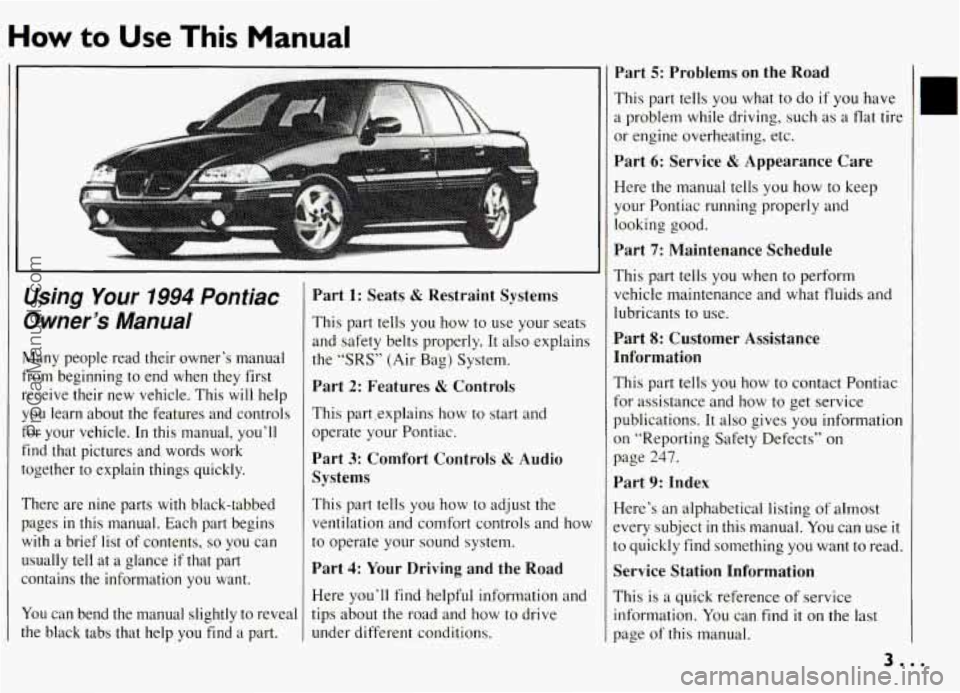
How to Use This Manual
It
Using Your 1994 Pontiac
Owner’s Manual
I‘
Many people read their owner’s manual
from beginning
to end when they first
receive their new vehicle. This will help
you learn about the features and controls
for your vehicle. In this manual, you’ll
find that pictures and words work
together to explain things quickly.
There are nine parts with black-tabbed
pages
in this manual. Each part begins
with a brief list of contents, so you can
usually tell at a glance
if that part
contains the information you want.
You can bend the manual slightly to reveal
the black tabs that help you find a part.
I
Part 1: Seats & Restraint Systems
This part tells you how to use your seats
and safety belts properly. It also explains
the
“SRS” (Air Bag) System.
Part 2: Features & Controls
This part,explains how to start and
operate your Pontiac.
Part 3: Comfort Controls & Audio
Systems
This part tells you how to adjust the
ventilation and comfort controls and how
to operate your sound system.
Part 4: Your Driving and the Road
Here you’ll find helpful information and
tips about
the road and how to drive
under different conditions.
Part 5: Problems on the Road
This part tells you what to do if you have
a problem while driving, such as a flat tire
or engine overheating, etc.
Part 6: Service & Appearance Care
Here the manual tells you how to keep
your Pontiac running properly and
looking good.
Part 7: Maintenance Schedule
This part tells you when to perform
vehicle maintenance and what fluids and
lubricants to use.
Part 8: Customer Assistance
Information
This part tells you how to contact Pontiac
for assistance and how to get service
publications. It
also gives you information
on “Reporting Safety Defects’’ on
page 247.
Part 9: Index
Here’s an alphabetical listing of almost
?very subject
in this manual. You can use it
to quickly find something you want to read.
Service Station Information
This is a quick reference of service
information.
You can find it on the last
page of this manual.
3.. .
ProCarManuals.com
Page 6 of 274
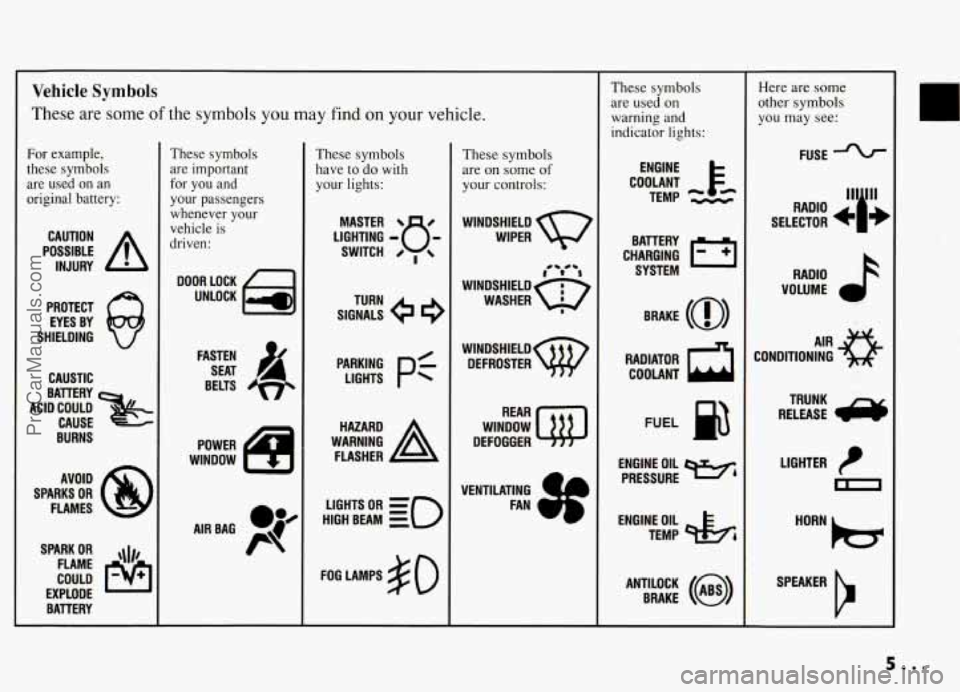
Vehicle Symbols
These are some of the symbols you may find on your vehicle.
For example,
these symbols
are used on an
original battery:
PROTECT
EYES BY
SHIELDING
CAUSTIC
BURNS
AVOID
SPARKS
OR
FLAMES
SPARK OR ,\I/,
COULD FLAME
EXPLODE BATTERY
These symbols
are important
for you and
your passengers
whenever your
vehicle is
driven:
DOOR LOCK
UNLOCK
FASTEN SEAT 4
BELTS
POWER
WINDOW
These symbols
have
to do with
your lights:
SIGNALS e
TURN
HIGH BEAM OR = =o
FOG LAMPS $0
These symbols
are
on some of
your controls:
WIPER Q
WINDSHIELD
WASHER
wlNDSHIELDw DEFROSTER
WINDOW REAR
DEFOGGER.
VENTILATING ca
FAN c.
These symbols
are used
on
warning and
indicator lights:
COOLANT F-
TEMP --
ENGINE
CHARGING BATTERY
SYSTEM
BRAKE (0)
RADIATOR a
COOLANT
FUEL
ENGINE OIL
PRESSURE
-4
TEMP OIL &
ANTILOCK (e)
BRAKE
Here are some
other symbols
you may
see:
FUSE *
RADIO
VOLUME
AIR
CONDITIONING
RELEASE TRUNK
LIGHTER
SPEAKER
b
ProCarManuals.com
Page 8 of 274
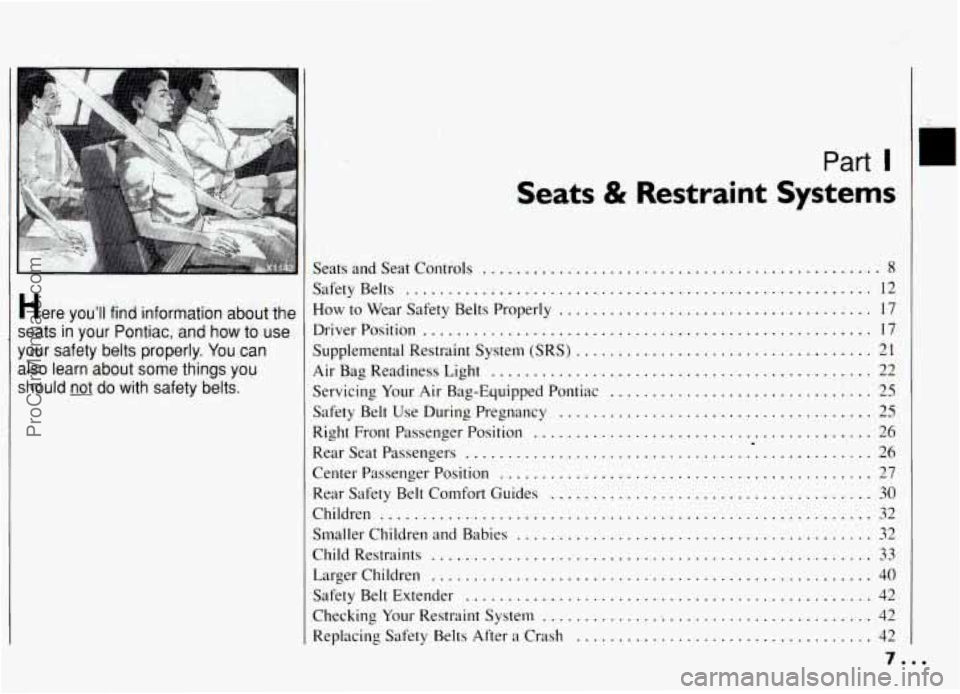
...
Her6 you'll find information about'the
seats in your Po.ntiac, and how ti, us0
your-safety belts properly . You can
also learn about
some thi, ngs you
should not dm o with safety belts .
I.
Seats & Restraint Sys
Seats and Seat Controls ........................................
El terns
...... 8
Part I
5. afety Belts .......... ; ............................................. 12
How to Wear Safety Belts Properly ...................................... 17
Driver Positian ...................................................... 17
Supplemental Restraint System (SRS) ....................... ............. 21
Air 'Bag Readiness Light
.............................................. 22
Servicing Your Air Bag-Equipped Pontiac
............................... 25
Safety Belt
Use During Pregnancy ..................................... 25
Right Front. Passenger Position
.........................................
Rear Seat Passengers ................................................ 26
Center Passenger Position ............................................ 27
Rear Safety Belt Comfort Guides ...................................... 30
Children
.......................................................... 32
Smaller Children and Babies
.......................................... 32
Child Restraints
.................................................... 33
LargerChildren
.................................................... 40
Safety Belt Extender
................................................ 42
Checking Your Restraint System ........................................ 42
Replacing Safety Belts After a Crash
................................... 42
. 26
I a..
ProCarManuals.com
Page 13 of 274
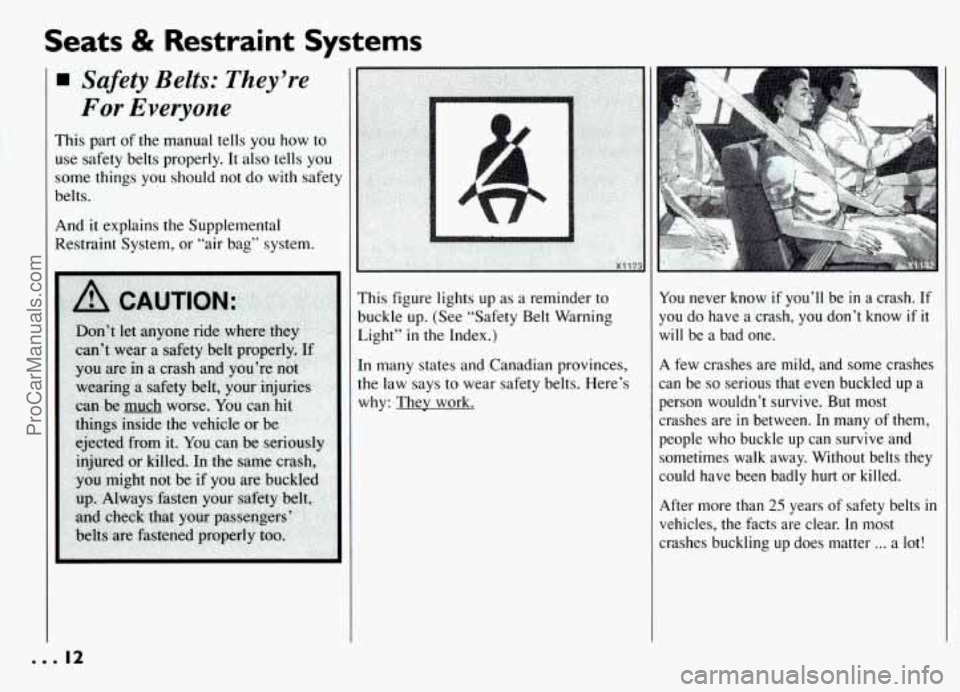
Seats & Restraint Systems
Safety Belts: They’re
For Everyone
This part of the manual tells you how to
use safety belts properly. It also tells you
some things you should not do with safety
belts.
And it explains the Supplemental
Restraint System, or “air bag” system.
This figure lights up as a reminder to
buckle
up. (See “Safety Belt Warning
Light”
in the Index.)
In many states and Canadian provinces,
the law says to wear safety belts. Here’s
why: They work.
You never know if you’ll be in a crash. If
you do have a crash, you don’t know
if it
will be a bad one.
A few crashes are mild, and some crashes
can be
so serious that even buckled up a
person wouldn’t survive. But most
crashes are
in between. In many of them,
people who buckle
up can survive and
sometimes walk away. Without belts they
could have been badly hurt or killed.
After more than 25 years of safety belts in
vehicles, the facts are clear. In most
crashes buckling up does matter
... a lot!
ProCarManuals.com
Page 17 of 274
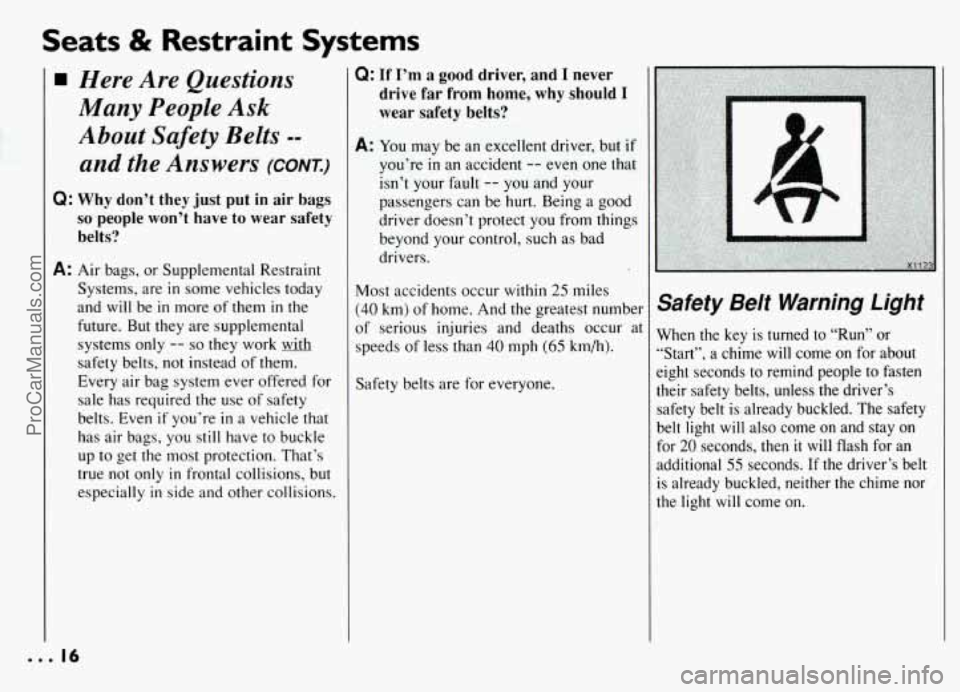
Seats & Restraint Systems
Here Are Questions
Many People
Ask
About Safety Belts --
and the Answers (CONT.)
Q: Why don’t they just put in air bags
so people won’t have to wear safety
belts?
A: Air bags, or Supplemental Restraint
Systems, are
in some vehicles today
and
will be in more of them in the
future. But they are supplemental
systems only
-- so they work with
safety belts, not instead of them.
Every air bag system ever offered for
sale has required the use of safety
belts. Even
if you’re in a vehicle that
has air bags, you
still have to buckle
up to get the most protection. That’s
true not only
in frontal collisions, but
especially
in side and other collisions.
Q: If I’m a good driver, and I never
drive far from home, why should I
wear safety belts?
A: You may be an excellent driver, but if
you’re in an accident -- even one that
isn’t your fault
-- you and your
passengers can be hurt. Being a good
driver doesn’t protect you from things
beyond your control, such as bad
drivers.
Most accidents occur within 25 miles
(40 km) of home. And the greatest number
of serious injuries and deaths occur at
speeds of less than
40 mph (65 km/h).
Safety belts are for everyone.
Safety Belt Warning Light
When the key is turned to “Run” or
“Start”, a chime
will come on for about
eight seconds to remind people to fasten
their safety belts, unless the driver’s safety belt is already buckled. The safety
belt
light will also come on and stay on
for 20 seconds, then it will flash for an
additional
55 seconds. If the driver’s belt
is already buckled, neither the chime nor
the light will come on.
... 16
ProCarManuals.com
Page 23 of 274
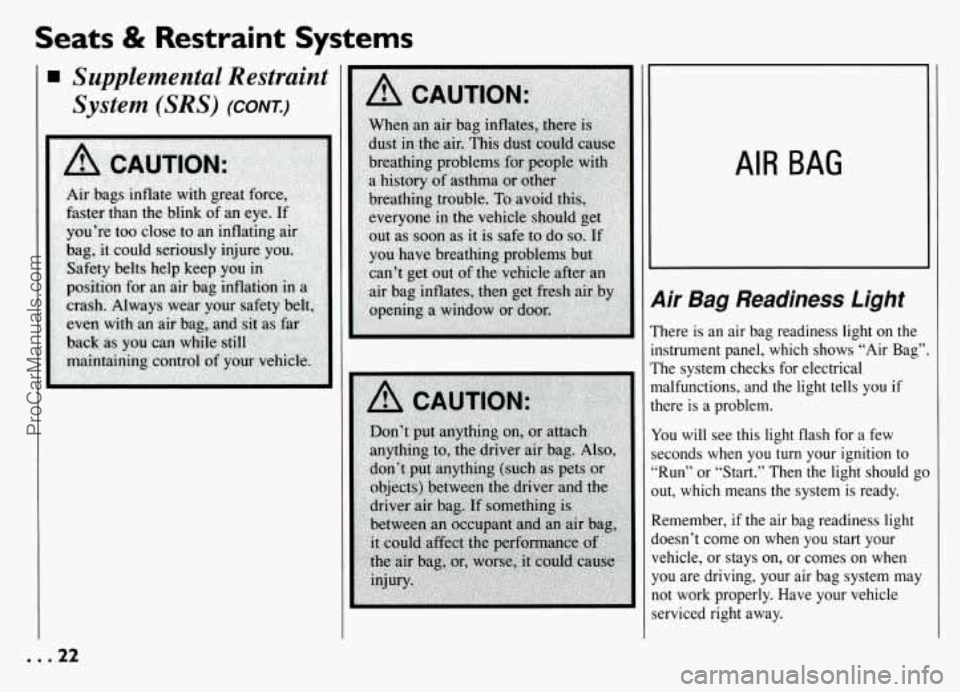
Seats & Restraint Systems
Supplemental Restraint
System (SRS)
(CONE)
AIR BAG
9ir Bag Readiness Light
:here is an air bag readiness light on the
nstrument panel, which shows “Air Bag”
’he system checks for electrical
nalfunctions, and the light tells you
if
here is a problem.
lou will see this light flash for a few
seconds when
you turn your ignition to
‘Run” or “Start.” Then the light should g
)ut, which means the system is ready.
Remember, if the air bag readiness light
ioesn’t come on when you start your
vehicle, or stays on,
or comes on when
you are driving, your air bag system may
not work properly. Have your vehicle
serviced right away.
... 22
ProCarManuals.com
Page 46 of 274
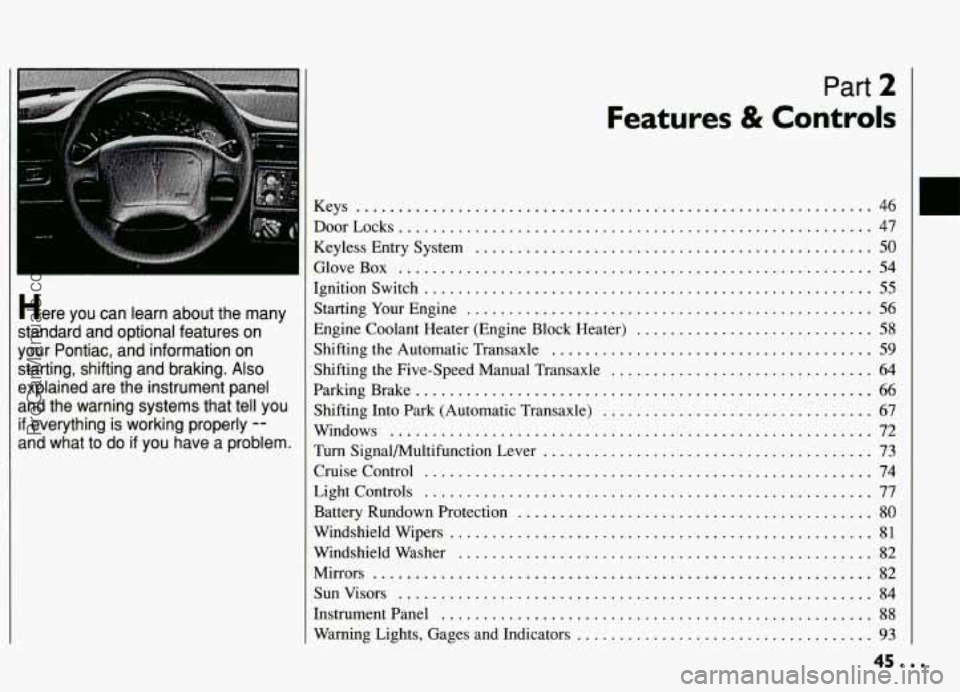
...
dele you can learn about the many
tandard and optional features on our Pontiac. and information on
tarting. shifting and braking
. Also
!xplained are the instrument panel
nd the warning systems that tell you
’ everything is working properly ..
ind what to do if you have a problem .
Part 2
Features & Controls
Keys ..... ....................................................... 46
DoorLocks ........................................................ 47
Keyless Entry System
............................................... 50
GloveBox ........................................................ 54
Ignitionswitch
..................................................... 55
StartingYourEngine ................................................ 56
Engine Coolant Heater (Engine Block Heater) ............................ 58
Shifting the Automatic Transaxle ...................................... 59
Shifting the Five-Speed Manual Transaxle ............................... 64
Shifting Into Park (Automatic Transaxle) ................................ 67
Windows
......................................................... 72
Turn Signal/Multifunction Lever ....................................... 73
CruiseControl
..................................................... 74
Lightcontrols
..................................................... 77
Battery Rundown Protection
.......................................... 80
Windshield Wipers .................................................. 81
Windshield Washer ................................................. 82
Mirrors ........................................................... 82
SunVisors ........................................................ 84
Instrumentpanel ................................................... 88
Warning Lights, Gages and Indicators ................................... 93
ParkingBrake ...................................................... 66
45.0.
ProCarManuals.com
Page 50 of 274
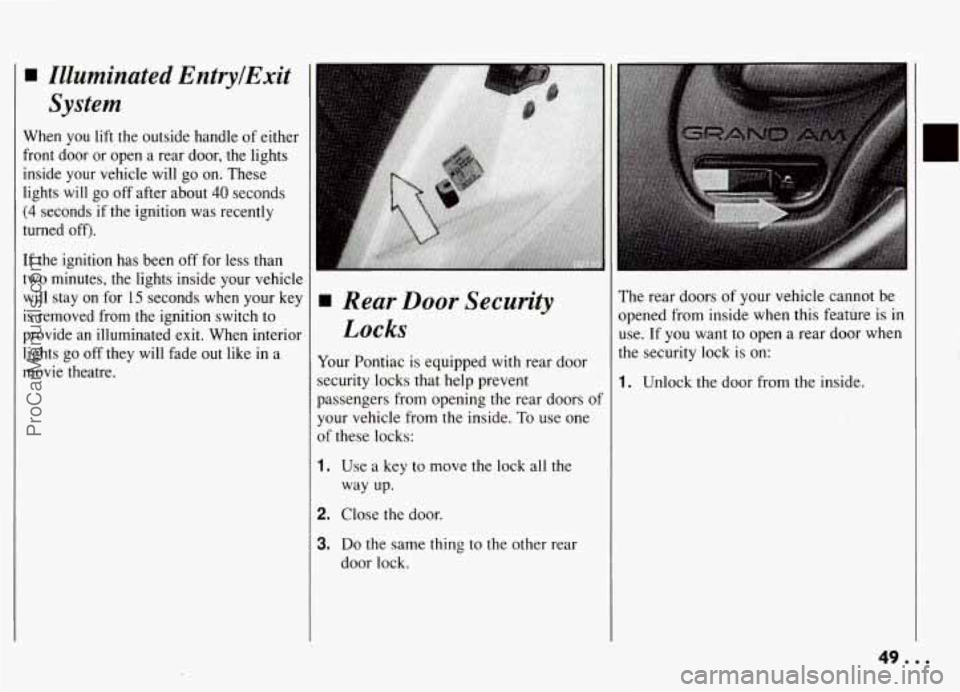
Illuminated EPttrylExit
System
When you lift the outside handle of either
front door or open a rear door, the lights
inside your vehicle will go on. These
lights will go
off after about 40 seconds
(4 secQnds if the ignition was recently
turned off).
If the ignition has been off for less than
two minutes, the lights inside your vehicle
will stay on for 15 seconds when your key
is removed from the ignition switch to
provide an illuminated exit. When interior
lights go off they will fade
out like in a
movie theatre.
Rear Door Security
Locks
Your Pontiac is equipped with rear door
security locks that help prevent
passengers from opening the rear doors of
your vehicle from the inside.
To use one
of these locks:
1. Use a key to move the lock all the
way up.
2. Close the door.
3. Do the same thing to the other rear
door lock.
The rear doors of your vehicle cannot be
opened from inside when this feature is in
use. If you want to open a rear door when
the security lock is on:
?!. .
1. Unlock the door from the inside.
. ..
y.
ProCarManuals.com
Page 52 of 274
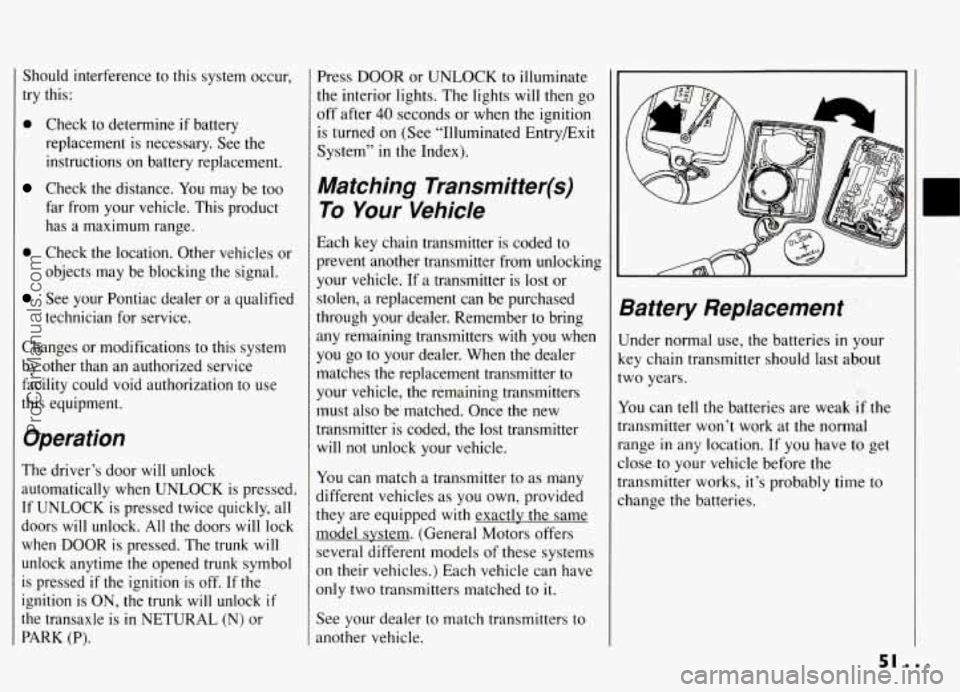
Should interference to this system occur,
try this:
0 Check to determine if battery
replacement is necessary. See the
instructions on battery replacement.
Check the distance. You may be too
far from your vehicle. This product
has a maximum range.
0 Check the location. Other vehicles or
objects may be blocking the signal.
See your Pontiac dealer or a qualified
technician for service.
Changes or modifications to this system
by other
than an authorized service
facility could void authorization to use
this equipment.
Operation
The driver’s door will unlock
automatically
when UNLOCK is pressed.
If UNLOCK
is pressed twice quickly, all
doors
will unlock. All the doors will lock
when DOOR is pressed. The trunk will
unlock anytime the opened trunk symbol is pressed
if the ignition is off. If the
ignition is
ON, the trunk will unlock if
the transaxle is in NETURAL (N) or
PARK (P).
Press DOOR or UNLOCK to illuminate
the interior lights. The lights will then go
off after
40 seconds or when the ignition
is turned on (See “Illuminated Entry/Exit
System”
in the Index).
Matching Transmitter(s)
To Your Vehicle
Each key chain transmitter is coded to
prevent another transmitter from unlocking
your vehicle. If a transmitter is lost or
stolen, a replacement can be purchased
through your dealer. Remember to bring
any remaining transmitters
with you when
you
go to your dealer. When the dealer
matches the replacement transmitter to
your vehicle,
the remaining transmitters
must also
be matched. Once the new
transmitter is coded, the lost transmitter
will not unlock your vehicle.
You can match a transmitter to as many
different vehicles as you own, provided
they are equipped
with exactly the same
model system. (General Motors offers
several different models of these systems
on
their vehicles.) Each vehicle can have
only two transmitters matched to
it.
See your dealer to match transmitters to
another vehicle.
3attery Replacement
Jnder normal use, the batteries in your
ey chain transmitter should last about
NO years.
‘ou can tell the batteries are weak i.f the
-ansmitter won’t work at
the normal
mge
in any location. If you have to get
lose to your vehicle before the
-ansmitter works, it’s probably
time to
hange the batteries.
51 ...
ProCarManuals.com
Page 53 of 274
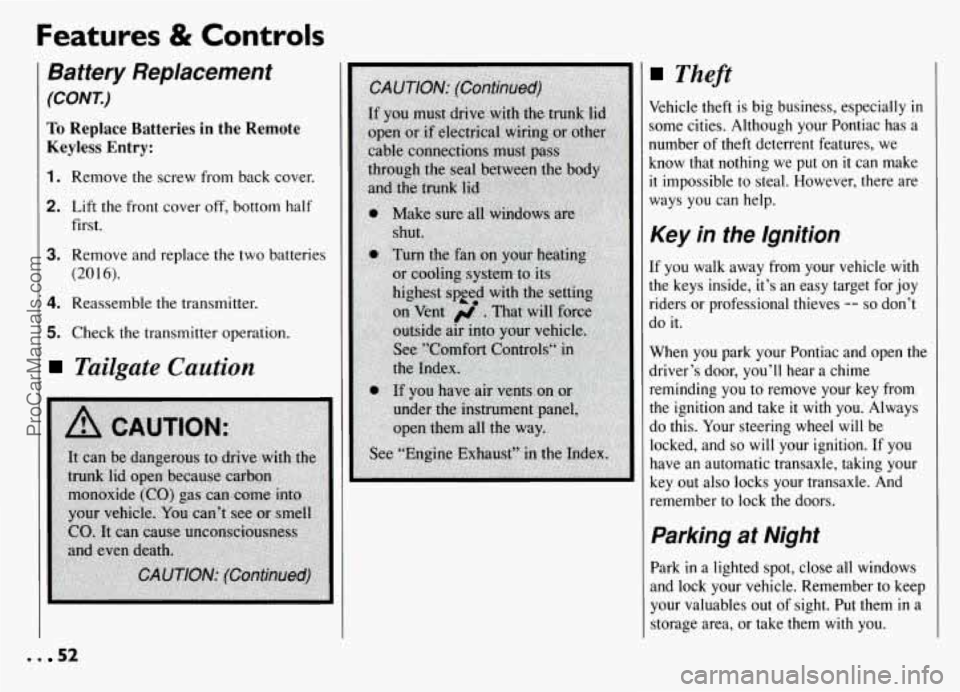
Features & Controls
Battery Replacement
(CONK)
To Replace Batteries in the Remote
Keyless Entry:
1. Remove the screw from back cover.
2. Lift the front cover off, bottom half
first.
3. Remove and replace the two batteries
(2016).
4. Reassemble the transmitter.
5. Check the transmitter operation.
Tailgate Caution
. . 52
Theft
Vehicle theft is big business, especially in
some cities. Although your Pontiac has a
number of theft deterrent features, we
know that nothing we put on
it can make
it impossible to steal. However, there are
ways you can help.
Key in the Ignition
If you walk away from your vehicle with
the keys inside, it’s an easy target for joy
riders or professional thieves
-- so don’t
do
it.
When you park your Pontiac and open the
driver’s door, you’ll hear a chime
reminding you to remove your key from
the ignition and take
it with you. Always
do this. Your steering wheel will be
locked, and
so will your ignition. If you
have an automatic transaxle, taking your
key out also locks your transaxle. And
remember to lock the doors.
Parking at Night
Park in a lighted spot, close all windows
and lock your vehicle. Remember to keep
your valuables out of sight. Put them
in a
storage area, or take them with you.
ProCarManuals.com